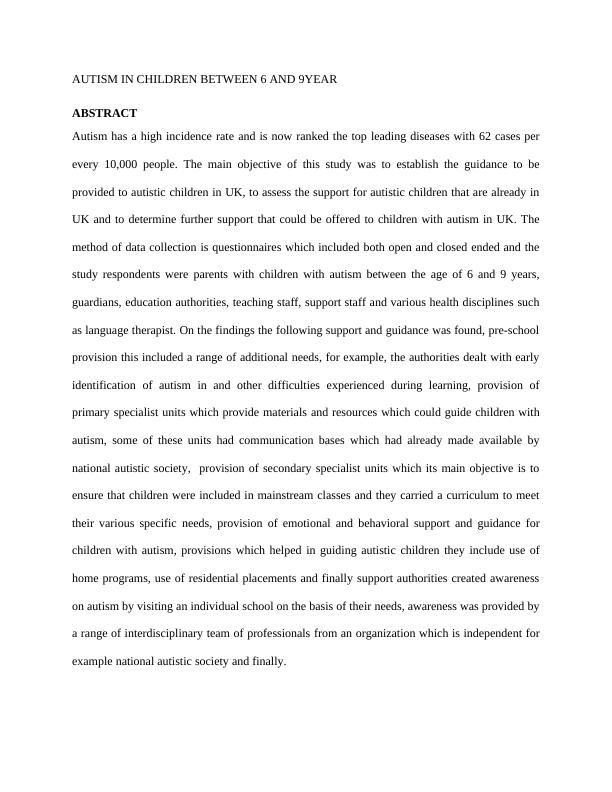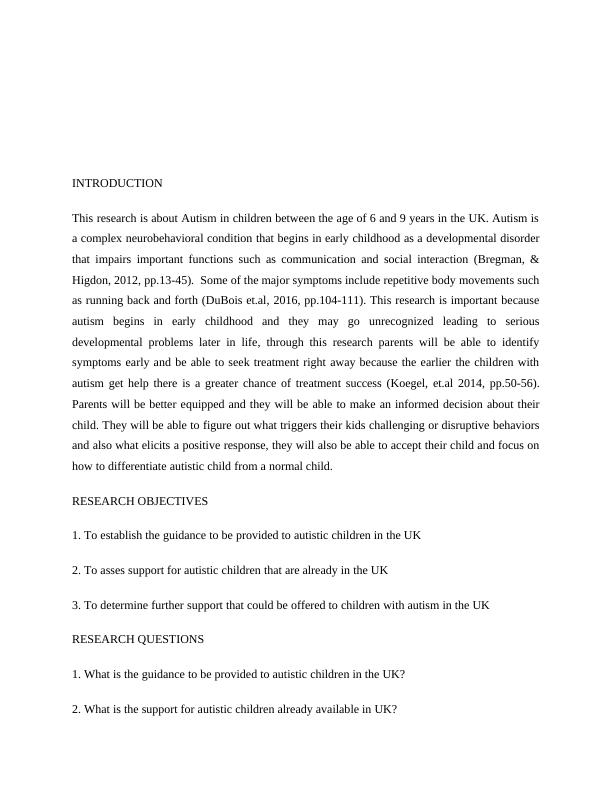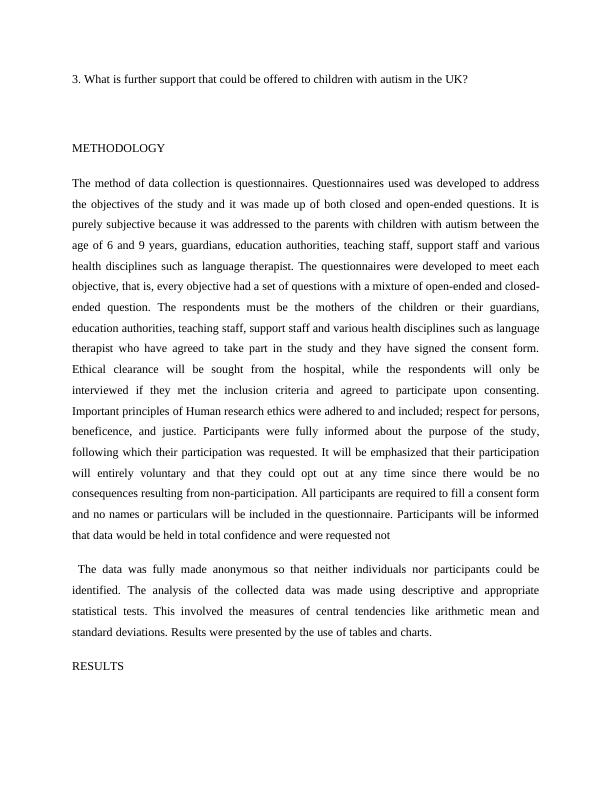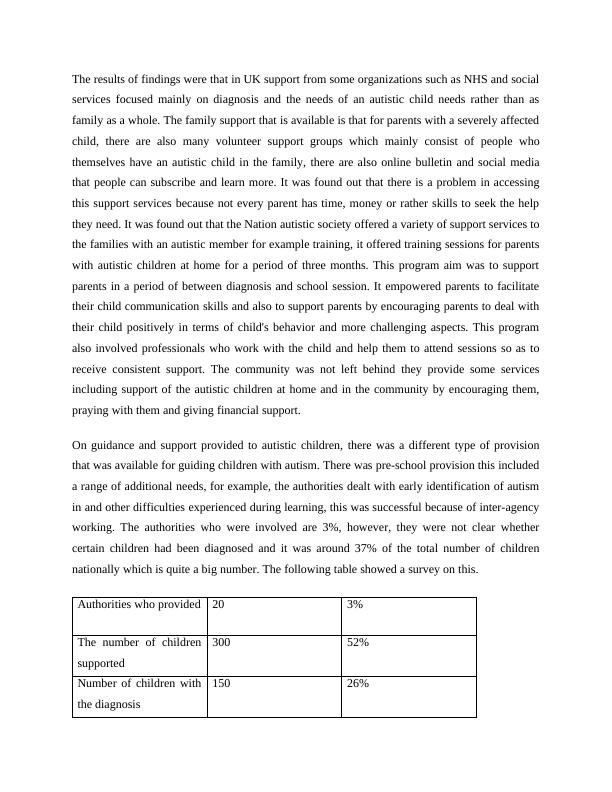Autism in Children: Guidance and Support in the UK
Added on 2022-12-23
13 Pages3830 Words51 Views
AUTISM IN CHILDREN BETWEEN 6 AND 9YEAR
ABSTRACT
Autism has a high incidence rate and is now ranked the top leading diseases with 62 cases per
every 10,000 people. The main objective of this study was to establish the guidance to be
provided to autistic children in UK, to assess the support for autistic children that are already in
UK and to determine further support that could be offered to children with autism in UK. The
method of data collection is questionnaires which included both open and closed ended and the
study respondents were parents with children with autism between the age of 6 and 9 years,
guardians, education authorities, teaching staff, support staff and various health disciplines such
as language therapist. On the findings the following support and guidance was found, pre-school
provision this included a range of additional needs, for example, the authorities dealt with early
identification of autism in and other difficulties experienced during learning, provision of
primary specialist units which provide materials and resources which could guide children with
autism, some of these units had communication bases which had already made available by
national autistic society, provision of secondary specialist units which its main objective is to
ensure that children were included in mainstream classes and they carried a curriculum to meet
their various specific needs, provision of emotional and behavioral support and guidance for
children with autism, provisions which helped in guiding autistic children they include use of
home programs, use of residential placements and finally support authorities created awareness
on autism by visiting an individual school on the basis of their needs, awareness was provided by
a range of interdisciplinary team of professionals from an organization which is independent for
example national autistic society and finally.
ABSTRACT
Autism has a high incidence rate and is now ranked the top leading diseases with 62 cases per
every 10,000 people. The main objective of this study was to establish the guidance to be
provided to autistic children in UK, to assess the support for autistic children that are already in
UK and to determine further support that could be offered to children with autism in UK. The
method of data collection is questionnaires which included both open and closed ended and the
study respondents were parents with children with autism between the age of 6 and 9 years,
guardians, education authorities, teaching staff, support staff and various health disciplines such
as language therapist. On the findings the following support and guidance was found, pre-school
provision this included a range of additional needs, for example, the authorities dealt with early
identification of autism in and other difficulties experienced during learning, provision of
primary specialist units which provide materials and resources which could guide children with
autism, some of these units had communication bases which had already made available by
national autistic society, provision of secondary specialist units which its main objective is to
ensure that children were included in mainstream classes and they carried a curriculum to meet
their various specific needs, provision of emotional and behavioral support and guidance for
children with autism, provisions which helped in guiding autistic children they include use of
home programs, use of residential placements and finally support authorities created awareness
on autism by visiting an individual school on the basis of their needs, awareness was provided by
a range of interdisciplinary team of professionals from an organization which is independent for
example national autistic society and finally.

INTRODUCTION
This research is about Autism in children between the age of 6 and 9 years in the UK. Autism is
a complex neurobehavioral condition that begins in early childhood as a developmental disorder
that impairs important functions such as communication and social interaction (Bregman, &
Higdon, 2012, pp.13-45). Some of the major symptoms include repetitive body movements such
as running back and forth (DuBois et.al, 2016, pp.104-111). This research is important because
autism begins in early childhood and they may go unrecognized leading to serious
developmental problems later in life, through this research parents will be able to identify
symptoms early and be able to seek treatment right away because the earlier the children with
autism get help there is a greater chance of treatment success (Koegel, et.al 2014, pp.50-56).
Parents will be better equipped and they will be able to make an informed decision about their
child. They will be able to figure out what triggers their kids challenging or disruptive behaviors
and also what elicits a positive response, they will also be able to accept their child and focus on
how to differentiate autistic child from a normal child.
RESEARCH OBJECTIVES
1. To establish the guidance to be provided to autistic children in the UK
2. To asses support for autistic children that are already in the UK
3. To determine further support that could be offered to children with autism in the UK
RESEARCH QUESTIONS
1. What is the guidance to be provided to autistic children in the UK?
2. What is the support for autistic children already available in UK?
This research is about Autism in children between the age of 6 and 9 years in the UK. Autism is
a complex neurobehavioral condition that begins in early childhood as a developmental disorder
that impairs important functions such as communication and social interaction (Bregman, &
Higdon, 2012, pp.13-45). Some of the major symptoms include repetitive body movements such
as running back and forth (DuBois et.al, 2016, pp.104-111). This research is important because
autism begins in early childhood and they may go unrecognized leading to serious
developmental problems later in life, through this research parents will be able to identify
symptoms early and be able to seek treatment right away because the earlier the children with
autism get help there is a greater chance of treatment success (Koegel, et.al 2014, pp.50-56).
Parents will be better equipped and they will be able to make an informed decision about their
child. They will be able to figure out what triggers their kids challenging or disruptive behaviors
and also what elicits a positive response, they will also be able to accept their child and focus on
how to differentiate autistic child from a normal child.
RESEARCH OBJECTIVES
1. To establish the guidance to be provided to autistic children in the UK
2. To asses support for autistic children that are already in the UK
3. To determine further support that could be offered to children with autism in the UK
RESEARCH QUESTIONS
1. What is the guidance to be provided to autistic children in the UK?
2. What is the support for autistic children already available in UK?

3. What is further support that could be offered to children with autism in the UK?
METHODOLOGY
The method of data collection is questionnaires. Questionnaires used was developed to address
the objectives of the study and it was made up of both closed and open-ended questions. It is
purely subjective because it was addressed to the parents with children with autism between the
age of 6 and 9 years, guardians, education authorities, teaching staff, support staff and various
health disciplines such as language therapist. The questionnaires were developed to meet each
objective, that is, every objective had a set of questions with a mixture of open-ended and closed-
ended question. The respondents must be the mothers of the children or their guardians,
education authorities, teaching staff, support staff and various health disciplines such as language
therapist who have agreed to take part in the study and they have signed the consent form.
Ethical clearance will be sought from the hospital, while the respondents will only be
interviewed if they met the inclusion criteria and agreed to participate upon consenting.
Important principles of Human research ethics were adhered to and included; respect for persons,
beneficence, and justice. Participants were fully informed about the purpose of the study,
following which their participation was requested. It will be emphasized that their participation
will entirely voluntary and that they could opt out at any time since there would be no
consequences resulting from non-participation. All participants are required to fill a consent form
and no names or particulars will be included in the questionnaire. Participants will be informed
that data would be held in total confidence and were requested not
The data was fully made anonymous so that neither individuals nor participants could be
identified. The analysis of the collected data was made using descriptive and appropriate
statistical tests. This involved the measures of central tendencies like arithmetic mean and
standard deviations. Results were presented by the use of tables and charts.
RESULTS
METHODOLOGY
The method of data collection is questionnaires. Questionnaires used was developed to address
the objectives of the study and it was made up of both closed and open-ended questions. It is
purely subjective because it was addressed to the parents with children with autism between the
age of 6 and 9 years, guardians, education authorities, teaching staff, support staff and various
health disciplines such as language therapist. The questionnaires were developed to meet each
objective, that is, every objective had a set of questions with a mixture of open-ended and closed-
ended question. The respondents must be the mothers of the children or their guardians,
education authorities, teaching staff, support staff and various health disciplines such as language
therapist who have agreed to take part in the study and they have signed the consent form.
Ethical clearance will be sought from the hospital, while the respondents will only be
interviewed if they met the inclusion criteria and agreed to participate upon consenting.
Important principles of Human research ethics were adhered to and included; respect for persons,
beneficence, and justice. Participants were fully informed about the purpose of the study,
following which their participation was requested. It will be emphasized that their participation
will entirely voluntary and that they could opt out at any time since there would be no
consequences resulting from non-participation. All participants are required to fill a consent form
and no names or particulars will be included in the questionnaire. Participants will be informed
that data would be held in total confidence and were requested not
The data was fully made anonymous so that neither individuals nor participants could be
identified. The analysis of the collected data was made using descriptive and appropriate
statistical tests. This involved the measures of central tendencies like arithmetic mean and
standard deviations. Results were presented by the use of tables and charts.
RESULTS

The results of findings were that in UK support from some organizations such as NHS and social
services focused mainly on diagnosis and the needs of an autistic child needs rather than as
family as a whole. The family support that is available is that for parents with a severely affected
child, there are also many volunteer support groups which mainly consist of people who
themselves have an autistic child in the family, there are also online bulletin and social media
that people can subscribe and learn more. It was found out that there is a problem in accessing
this support services because not every parent has time, money or rather skills to seek the help
they need. It was found out that the Nation autistic society offered a variety of support services to
the families with an autistic member for example training, it offered training sessions for parents
with autistic children at home for a period of three months. This program aim was to support
parents in a period of between diagnosis and school session. It empowered parents to facilitate
their child communication skills and also to support parents by encouraging parents to deal with
their child positively in terms of child's behavior and more challenging aspects. This program
also involved professionals who work with the child and help them to attend sessions so as to
receive consistent support. The community was not left behind they provide some services
including support of the autistic children at home and in the community by encouraging them,
praying with them and giving financial support.
On guidance and support provided to autistic children, there was a different type of provision
that was available for guiding children with autism. There was pre-school provision this included
a range of additional needs, for example, the authorities dealt with early identification of autism
in and other difficulties experienced during learning, this was successful because of inter-agency
working. The authorities who were involved are 3%, however, they were not clear whether
certain children had been diagnosed and it was around 37% of the total number of children
nationally which is quite a big number. The following table showed a survey on this.
Authorities who provided 20 3%
The number of children
supported
300 52%
Number of children with
the diagnosis
150 26%
services focused mainly on diagnosis and the needs of an autistic child needs rather than as
family as a whole. The family support that is available is that for parents with a severely affected
child, there are also many volunteer support groups which mainly consist of people who
themselves have an autistic child in the family, there are also online bulletin and social media
that people can subscribe and learn more. It was found out that there is a problem in accessing
this support services because not every parent has time, money or rather skills to seek the help
they need. It was found out that the Nation autistic society offered a variety of support services to
the families with an autistic member for example training, it offered training sessions for parents
with autistic children at home for a period of three months. This program aim was to support
parents in a period of between diagnosis and school session. It empowered parents to facilitate
their child communication skills and also to support parents by encouraging parents to deal with
their child positively in terms of child's behavior and more challenging aspects. This program
also involved professionals who work with the child and help them to attend sessions so as to
receive consistent support. The community was not left behind they provide some services
including support of the autistic children at home and in the community by encouraging them,
praying with them and giving financial support.
On guidance and support provided to autistic children, there was a different type of provision
that was available for guiding children with autism. There was pre-school provision this included
a range of additional needs, for example, the authorities dealt with early identification of autism
in and other difficulties experienced during learning, this was successful because of inter-agency
working. The authorities who were involved are 3%, however, they were not clear whether
certain children had been diagnosed and it was around 37% of the total number of children
nationally which is quite a big number. The following table showed a survey on this.
Authorities who provided 20 3%
The number of children
supported
300 52%
Number of children with
the diagnosis
150 26%

End of preview
Want to access all the pages? Upload your documents or become a member.
Related Documents
Evaluate the level of educational and psychological support for children with Autismlg...
|39
|11713
|492
Impact Of Disability On Early Childhood Education Research Paper 2022lg...
|9
|2726
|21
Autism Spectrum Disorder Disease Analysislg...
|4
|814
|14
Collaboration between Schools and Parents of Autistic Childrenlg...
|8
|2533
|50
The exploration of the current statelg...
|15
|2780
|13
Effective Methods to Encourage Children with Autism to Interact with Otherslg...
|12
|2618
|80
